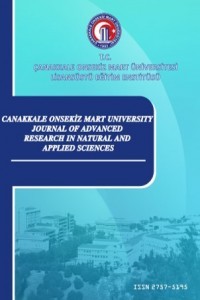Group-Based Authentication Methods in The OneM2M Ecosystem
Group-Based Authentication Methods in The OneM2M Ecosystem
Group-based authentication, internet of things, oneM2M open-source IoT server platform, security,
___
- Aydin, Y., Kurt, G. K., Ozdemir, E., & Yanikomeroglu, H. (2020). A flexible and lightweight group Authentication Scheme. IEEE Internet of Things Journal, 7(10), 10277-10287. DOI: https://www.doi.org/10.1109/jiot.2020.3004300
- Apache JMeter. Retrieved June 6, 2020, from http://jmeter.apache.org
- Cao, J., Ma, M., & Li, H. (2015). GBAAM: Group-based Access Authentication for MTC in LTE Networks. Security and Communication Networks, 8(17), 3282-3299. DOI: https://www.doi.org/10.1002/sec.1252
- Chen, Y., Wang, J., Chi, K., & Tseng, C. (2010). Group-based Authentication and Key Agreement. Wireless Personal Communications, 62(4), 965-979. DOI: https://www.doi.org/10.1007/s11277-010-0104-7
- Define IOT. (2015, May 25). Retrieved October 22, 2019, from https://iot.ieee.org/definition.html
- Fu, A., Song, J., Li, S., Zhang, G., & Zhang, Y. (2016). A privacy-preserving group authentication protocol for machine-type communication in LTE/LTE-A Networks. Security and Communication Networks. DOI: https://www.doi.org/10.1002/sec.1455
- Gartner says 5.8 billion enterprise and automotive IoT endpoints will be in use in 2020. (2019, August 29). Retrieved February 12, 2020, from https://www.gartner.com/en/newsroom/press-releases/2019-08-29-gartner-says-5-8-billion-enterprise-and-automotive-io
- Gartner says worldwide IoT security spending will reach $1.5 billion in 2018. (2018, March 21). Retrieved May 07, 2019, from https://www.gartner.com/en/newsroom/press-releases/2018-03-21-gartner-says-worldwide-iot-security-spending-will-reach-1-point-5-billion-in-2018
- IoT Analytics, State of the IoT 2018: Number of IoT devices now at 7B – market accelerating. (2018, August 08). Retrieved March 19, 2020, from https://iot-analytics.com/state-of-the-iot-update-q1-q2-2018-number-of-iot-devices-now-7b
- IoT Analytics, State of the IoT 2022: Number of connected IoT devices growing 18% to 14.4 billion globally. (2022, May 18). Retrieved June 22, 2022, from https://iot-analytics.com/number-connected-iot-devices
- IoT OCEAN. (2017, July 9). Retrieved from http://developers.iotocean.org/archives/module/mobius
- Jiang, R., Lai, C., Luo, J., Wang, X., & Wang, H. (2013). EAP-based group Authentication and Key Agreement Protocol for machine-type communications. International Journal of Distributed Sensor Networks, 9(11), 304601. DOI: https://www.doi.org/10.1155/2013/304601
- RFC7519. (2015, May). Retrieved April 21, 2020, from https://datatracker.ietf.org/doc/html/rfc7519
- KETI. (1991, August). Retrieved from https://www.keti.re.kr
- Kim, J., Choi, S., Yun, J., & Lee, J. (2016). Towards the onem2M standards for building IoT ecosystem: Analysis, implementation, and lessons. Peer-to-Peer Networking and Applications, 11(1), 139-151. DOI: https://www.doi.org/10.1007/s12083-016-0505-9
- Lai, C., Li, H., Li, X., & Cao, J. (2013). A novel group access authentication and key agreement protocol for machine-type communication. Transactions on Emerging Telecommunications Technologies, 26(3), 414-431. DOI: https://www.doi.org/10.1002/ett.2635
- Lai, C., Li, H., Lu, R., & Shen, X. (2013). SE-AKA: A secure and efficient group authentication and key agreement protocol for LTE Networks. Computer Networks, 57(17), 3492-3510. DOI: https://www.doi.org/10.1016/j.comnet.2013.08.003
- Lai, C., Lu, R., Zheng, D., Li, H., & (Sherman) Shen, X. (2016). GLARM: Group-based Lightweight Authentication Scheme for resource-constrained machine-to-machine communications. Computer Networks, 99, 66-81. DOI: https://www.doi.org/10.1016/j.comnet.2016.02.007
- Li, J., Wen, M., & Zhang, T. (2016). Group-based Authentication and key agreement with Dynamic Policy Updating for MTC in LTE-A Networks2. IEEE Internet of Things Journal, 3(3), 408-417. DOI: https://www.doi.org/10.1109/jiot.2015.2495321
- Modiri, M. M., Mohajeri, J., & Salmasizadeh, M. (2018). GSL-AKA: Group-based Secure Lightweight Authentication and key agreement protocol for M2M communication. 2018 9th International Symposium on Telecommunications (IST). DOI: https://www.doi.org/10.1109/istel.2018.8661145
- MongoDB: The Application Data Platform. (2007). Retrieved May 04, 2020, from http://www.mongodb.com
- nCube-Lavender. (2018, May 30). Retrieved from http://developers.iotocean.org/archives/module/ncube-lavender
- nCube-Rosemary. (2018, May 31). Retrieved from http://developers.iotocean.org/archives/module/ncube-rosemary
- nCube-Thyme Nodejs. (2018, July 2). Retrieved from http://developers.iotocean.org/archives/module/ncube-thyme-nodejs
- OneM2M, the global community that develops standards for IoT. (2012). Retrieved from http://www.onem2m.org
- Parne, B. L., Gupta, S., & Chaudhari, N. S. (2018). SEGB: Security Enhanced Group-based AKA protocol for M2M Communication in an IoT enabled LTE/LTE-A Network. IEEE Access, 6, 3668-3684. DOI: https://www.doi.org/10.1109/access.2017.2788919
- Padmashree, M. G., Mallikarjun, Arunalatha, J. S., & Venugopal, K. R. (2022). GKEAE: Group Key Exchange and authentication with ECC in internet of things. Intelligent Systems, 1-10. DOI: https://www.doi.org/10.1007/978-981-19-0901-6_1
- Passport.js. Retrieved February 13, 2020, from http://www.passportjs.org
- Postman API Platform. Retrieved July 16, 2020, from https://www.postman.com
- Su, W., Wong, W., & Chen, W. (2016). A survey of performance improvement by Group-based authentication in IoT. 2016 International Conference on Applied System Innovation (ICASI). DOI: https://www.doi.org/10.1109/icasi.2016.7539800
- Şahinaslan, O. (2019). Encryption protocols on wireless IOT Tools. AIP Conference Proceedings. DOI: https://www.doi.org/10.1063/1.5095121
- The Alliance for Internet of Things Innovation. (2019, October). IoT LSP Standard Framework Concepts, Release 2.9 AIOTI WG03 - IoT Standardization
- TR-0025 Technical Report. (2018, March 12). TR-0025 V2.0.2 Application Developer Guide.
- TS-0001 Technical Specification. (2016, August 30). TS-0001 V2.10.0 Functional Architecture.
- TS-0003 Technical Specification. (2018, March 12). TS-0003 V2.12.1 Security Solutions.
- TS-0009 Technical Specification. (2016, August 30). TS-0009 V2.6.1 HTTP Protocol Binding.
- Yao, J., Wang, T., Chen, M., Wang, L., & Chen, G. (2016). GBS-AKA: Group-based Secure Authentication and Key Agreement for M2M in 4G network. 2016 International Conference on Cloud Computing Research and Innovations (ICCCRI). DOI: https://www.doi.org/10.1109/icccri.2016.15
- Yayın Aralığı: Yılda 4 Sayı
- Başlangıç: 2015
- Yayıncı: Çanakkale Onsekiz Mart Üniversitesi
Evaluation of Consumers' Aspects on Organic Farming Products by Regions
Başak AYDIN, Murat DOĞU, Ayten AŞKIN KILINÇ, Sunay DEMİR, Bülent TARIM, Duygu AKTÜRK, Filiz PEZİKOĞLU, Volkan BURUCU, Mustafa ASLAN
Mehmet NAZ, Selin SAYIN, Zafer ÇETİN, Eyüp İlker SAYGILI, Ergün TAŞKIN, Oktay SÖYLER
An Integrated Risk Management Framework for Global Supply Chains
Group-Based Authentication Methods in The OneM2M Ecosystem
İbrahim Uğur ABA, Erhan TAŞKIN
Enhancing the Process of AES: A Lightweight Cryptography Algorithm AES for Ad-hoc Environments
Mustafa ALHANDHAL, Alharith A. ABDULLAH, Oğuz ATA, Çağatay AYDİN
Sentiment Analysis from Face Expressions Based on Image Processing Using Deep Learning Methods
